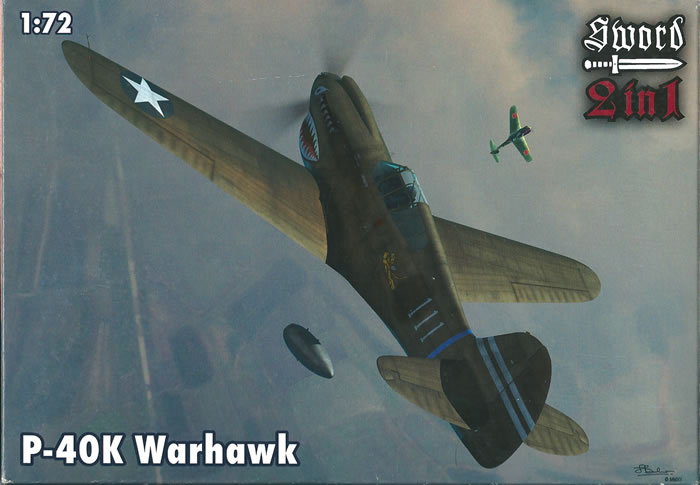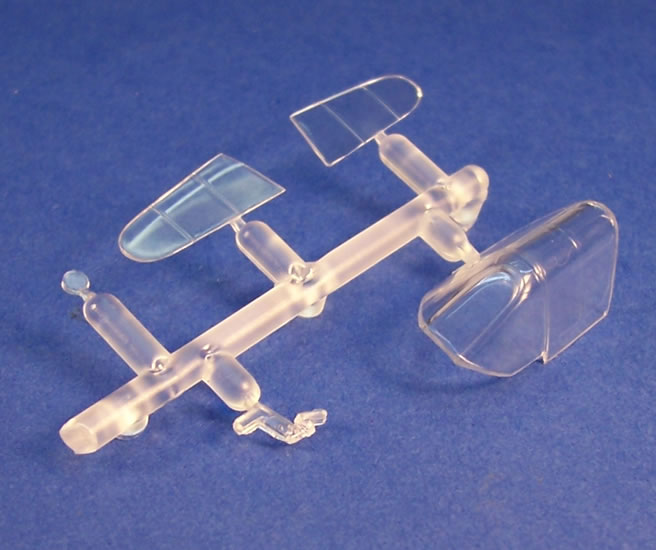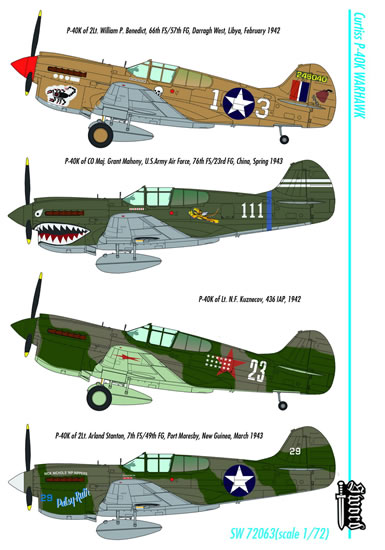Curtiss P-40K Warhawk
& Kittyhawk Mk.III

Sword, 1/72 scale
S u m m a r y : |
Catalogue Number: |
Sword
SW72063 Curtis P-40K Warhawk
SW72064 Curtis Kittyhawk Mk.III |
Scale: |
1/72 |
Contents & Media: |
Fifty-four grey styrene and four clear styrene parts per kit (so double this per box), with decals for three or four colour schemes depending on boxing. |
Price: |
Available online from these stockists: |
Stockist |
P-40K |
Kittyhawk III |
Hannants |
£11.66 |
£11.66 |
Squadron |
US$40.49 |
US$40.49 |
Modelimex |
€14.58 |
€14.58 |
West Coast Hobbys |
Can$22.50 |
Can$22.50 |
Review Type: |
First Look. |
Advantages: |
Great value because you get two kits per box. These are nicely engineered kits produced to high standards. They have a better quality feel to it than some other limited run brands, with fine and crisp parts. |
Disadvantages: |
None worth mentioning. |
Conclusion: |
These kits look to be a nice straightforward builds with good levels of detail. They are quality packages that would be good value with one, never mind two, kits per box (from most suppliers at least). It is pleasing to have a nice injected kit of this P-40 variant.
Highly recommended. |
Reviewed by
Mark Davies

Sword's 1/72 scale P-40K & Kittyhawk III are available online from Squadron.com
The general history of the P-40 is well known to many, so I shall not repeat it here. Instead, I shall just cover the key features of the P-40K, also known as the Kittyhawk III in British and commonwealth service.
To begin with, the P-40K was essentially a P-40E fitted with a more powerful version of the Allison engine used by most of the P-40 range. This extra power reduced the aircraft’s longitudinal stability, so Curtis added a fillet to the fin to increase its surface area in order to correct this problem. The fillet gave the first P-40K’s their distinctive appearance, although some of the last P-40E’s also had them fitted. The majority of P-40K’s had the same short fuselage type as the P-40E; these being, with production quantities in brackets, the P-40K-1-CU (600) and P-40K-5-CU (200). Later production aircraft, P-40K-10-CU (335) and P-40K-15-CU (165), did away with the fin fillet, and in its place, they had a 20-inch fuselage extension to the rear fuselage. The P-40F introduced this feature to fix the same stability problem, which stemmed from the extra power of its Merlin engine. Subsequent P-40 variants had the same long fuselage, which at least looked more elegant than the fin fillet.
Previous 1/72-Scale P-40K & Kittyhawk IIIs kits
I am aware of two previous P-40K or Kittyhawk III kits in 1/72-scale. The oldest by far was from Revell in the 1960’s, and it had all of the features that such dating implies. The other kit was a more modern release by Kovozavody Semily (re-boxed by Vista I think), which I seem to recall, had slightly heavy recessed panel lines and some shape issues.

As an aside, it seems a bit surprising that no P-40E have an alternate tail option to make a short-fuselage P-40K from the same kit. Of course, a fin fillet can be scratch-built to convert a P-40E kit, but I think many modellers will prefer to buy a P-40K ready to build.
The Contents
The kits come in end-opening boxes with artwork on their fronts. The P-40K artwork is positively bland; not that this matters much. Sword’s instructions provide a parts map and a generally easy to follow diagrammatic assembly format. The diagrams are well drawn and better than some long-run brands. There is also a history of the aircraft common to both the P40K and Kittyhawk III kits.
Paint colours are in Czech and English, with all other text in English. The painting and decal guide uses quite adequate black & white shaded 4-view drawings with colour profiles on the rear of the box. There is also a single page stencil placement guide. Sword uses generic and military colour names for colour call outs, for both detail painting and the paint and markings guide. The parts and decals come together enclosed in a zip-lock bag, with the clear parts in a small bag of their own. But wait there’s more... You get two complete kits per box, as indicated by the “2 in 1” text below the Sword logo on the box fronts. This makes for great value, although some might prefer one kit and cheaper price. However, I doubt that the price would be much less than the two kit to one box option, as the plastic is but a small part of the production and distribution cost.
This is a typical Sword kit in that the plastic has a more shiny finish than many other limited run brands. It has nicely moulded parts with very fine surface detail. Parts break down is conventional for the type. The sprue gates are narrow, and there is some flash in some places, but this a minor issue. The clear parts are good, with the canopy fixed in the closed position.

The P-40K and Kittyhawk III share the same sprues; only the decals, instructions and box-art differ.
The Airframe
Cockpit detail is quite reasonable for the scale. There is a floor, rear amour, seat frame and seat, rudder pedals, control column, instrument panel, gun-sight, and sidewall detail moulded with the fuselage halves. I liked the fact that the floor correctly simulates the curved upper surface of the wing. Some seatbelts would be my only addition for a closed canopy model.
The radiator and oil cooler are nicely done, and the real plus is that Sword has included both open and closed radiator gills. I wish that other kit makers would do this on a regular basis. The exhausts are delicate and well rendered; they fit through the fuselage onto backing plates, which means they can be left off until painting is completed. The prop blades and spinner are similar in finesse to those found in the better mainstream P-40 kits. This covers all the items enclosed by the fuselage halves except for the small interior floor of the tail wheel well.
I thought at first that the bulges in the underwing gun access hatches were over-pronounced, but having checked photos, I think they are okay. I you disagree then all that is needed is some light sanding. The protruding gun barrels are moulded as separate blocks that insert into the wing leading edge. This is much better than splitting the guns horizontally with the wings as some older P-40 kits do.
The detail in the wheel wells is quite good and their door thickness is within the limits of what is possible with injection moulding. The undercarriage legs are fine, but the wheels come in two halves because of the limited run moulds.
All that remains to mention is the centre-line drop tank with its sway braces, a pitot, nice clear canopy parts and a rear vision mirror. I think this should be a simple and enjoyable kit to build, or rather kits to build; as remember you get two to the box in both cases.
Colours & Markings
The P-40K Warkhawk boxing has four options; these are for three American and one Soviet machine:
-
2Lt. William P. Benedict, 66th FS/57th FG, USAAF, Darragh West, Libya, February 1942 (Sand over neutral gray with red spinner),
-
Maj. Grant Mahony, Co of 76th FS/23rd FG, USAAF, China, Spring 1943 (Olive drab over neutral gray),
-
2Lt. Arland Stanton, 7th FS/49th FG, USAAF, Port Moresby, New Guinea, March 1943 (Disruptive pattern dark green and dark earth over neutral gray with white spinner), and
-
Lt. N.F.Kuznecov, 436 IAP, Soviet Navy AF, 1942 (Disruptive pattern dark green and dark earth over sky or neutral gray). I have seen this aircraft attributed as a Kittyhawk III in some references, in which case sky undersides would seem likely.

The Kittyhawk III boxing has three options; all are disruptive pattern mid-stone and dark earth over azure blue with red spinners:
-
Maj. D.B.Hauptlleisch, No 2 ”Flying Cheetahs” Sqn SAAF, flown by 1942,
-
F/Lt. Frank Schaaf, No 450 Sqn RAAF, Malta, July 1943, and
-
No 112 Sqn RAF, Italy, October 1943.

The paint and markings guide with both kits is quite adequate, whilst the stencil guide covers the placement of over 50 decals. Techmod prints the decals, which appear to be very good overall.
These P-40K and Kittyhawk III kits are far superior to their predecessors. Although it is not too hard to convert a P-40E into a P-40K, I think that most will prefer to save the hassle and build the Sword kits. The limited run nature of these kits is barely an issue, and they feature some good detail. I like the choice of open or closed radiator flaps and the engineering of the wing guns.
These look to be excellent kits, and I am sure they will please many P-40 fans. I have also to comment on the price of these kits from most suppliers; they are simply great value in my opinion, especially when you allow for the fact there are two kits per box. It should come as no surprise that I highly recommend both of these kits.
Thanks to Sword Models for this review sample.
Review Text & Blue Background Images Copyright © 2012 by Mark Davies
Page Created 28 August, 2012
Last updated
28 August, 2012
Back to HyperScale Main Page

|
